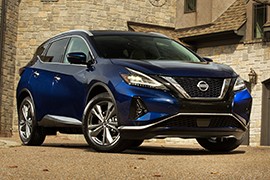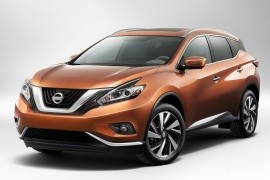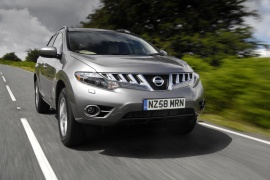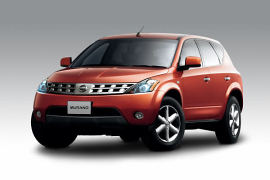NISSAN Murano Models/Series Timeline, Specifications & Photos
First production year: 2003
Engines: Gasoline, Hybrid gasoline, Diesel
Body style: SUV (Sports Utility Vehicle)
Nissan refreshed the third generation of the Murano in 2018 for the 2019 model year, adding more flavor to the stylish crossover vehicle.
Although a well-known off-road automaker, Nissan introduced the Murano lineup without any off-road-inspired cladding and technology. Moreover, it was even offered with a two-door convertible bodywork. The third generation was launched in 2014 at the Los Angeles Auto Show, and the Japanese automaker chose the same environment in 2018 to unveil the facelifted version. But the refresh was slightly disappointing.
The third generation of the Murano was well-designed, and thus, Nissan felt to only partially improve the car's look. Still, it added LED lights all around, matching the trend in the automotive sector. Also, the front bumper was changed and now sported a new design for the lower area, with a broader center intake flanked by triangular clusters for the new LED fog lights. Moreover, the car could've been ordered with 18" or 20" light-alloy wheels, and three more colors were added to the options list. In addition, the car's exterior received chromed trims instead of satin-silver ones.
Customers could find the same cozy, warm interior with bucket seats at the front and a split-folding bench at the rear. One of the most significant improvements was the infotainment system, which now offered standard Android Auto and Apple Carplay technology, easing the connection with smartphones.
Under the hood, there were no apparent changes since the carmaker still offered the same 3.5-liter V6 paired with an X-Tronic (CVT) gearbox that sent power to the front wheels for the base trim level or in all corners.
The third generation of the big SUV Nissan Murano was unveiled at the 2014 Los Angeles Auto Show. The new design language completely changed the vehicle.
When the first Murano generation appeared, it was unusual to see an SUV without a ladder chassis underneath, but in 2015 it was unusual to see an SUV with a body-on-frame structure. Apart from a few American models, most of the others are unibody type.
The overall look was more aggressive and bolder than on the previous generation. Its boomerang style headlights were inspired by those installed on the Nissan 370 Z sports car. The lowered greenhouse and the raked A-pillars enhanced the drag coefficient. In the rear, the Z-theme for the taillights was continued.
Inside the Murano, Nissan installed zero-gravity seats for both front passengers and the rear outboard occupants. That kind of seats is designed to support the body weight of its occupant on a bigger area. Thus, there was a sensation of floating on a cloud instead of seating in a chair. At least, that's what they said. The 2015 Murano came with more legroom for the rear passengers. The infotainment unit was installed on the center console, integrated into its shape. The instrument cluster featured two big round dials and a TFT screen between for the board computer and other information required by the driver.
For the technical department, Nissan didn't look that it improved over the second generation. There was the same V6 engine mated to a CVT with either front or all-wheel-drive. The downside of the CVT was the limited towing capacity of only 1500 lbs (680 kg).
The Murano was the flagship of the Nissan's SUV lineup for the U.S. market. The second generation was unveiled at the 2007 Los Angeles Auto Show and sales started in 2008 as a 2009 model.
The first generation of the Murano was built mainly for the U.S. market, but there was a version for the Japanese market as well. The second generation took into account the European market but its sales were hardly affected by the world economic crisis. Its futuristic design was too much for customers and the sales slumped in more countries. In the U.K. it was withdrawn in 2011.
The second generation featured the same wheelbase as its predecessor, but the car was built on a new platform, named Nissan D. The most important exterior modifications were made on the front fascia, where a new pair of headlights, a new grille, and new hood found their place on the car. In 2011, a facelifted version was introduced and the taillights were enhanced with LED lights.
Inside, the Murano received four heated seats and a more refined interior. The 360 degrees “bird-eye view” monitor was a carry-over from the Infiniti range. The dashboard was redesigned and received new lights for the instrument cluster.
The all-wheel independent suspension was a good idea for Nissan. It was fitted as standard on the entire range and it offered more comfort. The engine bay was still dominated by a 3.5-liter V6 engine mated to a CVT.
Nissan was renowned for its SUVs and off-road vehicles, but it didn't have a competitor for the midsize crossover segment; until 2002.
The Japanese automaker offered a wide range of 4x4 and SUVs on the market, and the brand was also famous for many sport-utility vehicles such as the Pathfinder or the Patrol. Yet, it didn't have anything to compete in the midsize crossover segment, so it developed the Murano, which was based on the same platform as the Maxima. Thus, soon, the ovoid-shaped vehicle received the nickname "The Maxima of off-roaders."
With an intriguing design that resembled mostly a UFO rather than a regular car, the Murano sported a front fascia with a grid-like grille and a pair of headlights that resembled those installed on the Z350 sports car. The profile revealed an athletic stance, with an upkick on the D-pillars. The rounded shapes and the raked-forward rear windscreen added more flavor to the car. However, with its overall bubble-design bodywork, it didn't look that menacing on the road.
The interior took some inspiration from upscale models. Inside, there was room for up to five passengers. Yet, the middle seat on the rear bench was rather tiny for a grown-up. The Murano offered sat-nav, leather upholstery, and self-leveling HID lamps on the top trim level. The trunk could have been expanded thanks to the split-folding (60/40) rear benchs' seatback.
Under the hood, Nissan offered the 2003 Murano with only one engine: a 3.5-liter V6 paired with a CVT. For specific trim levels, that allowed a manual shifting mode with fixed gear ratios or a four-speed automatic.



